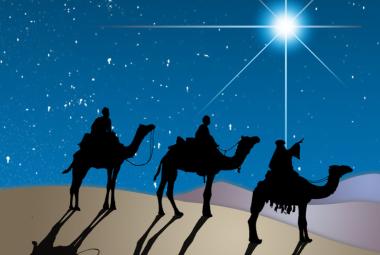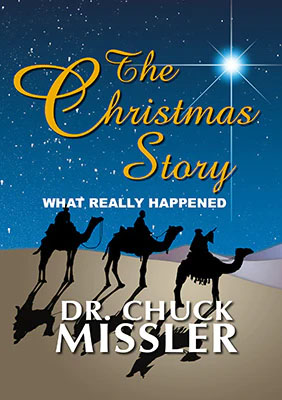When we go back to the birth of Christ and His genealogy, it is full of surprises. It is protected with a security system written into the text. There is an authentication code which acts like an automatic security monitor, and it watches every little letter of the text. The system never wears out, and it has been running continually for several thousand years. This is the fingerprint signature of the Author and it is designed to avoid compromise.
Sevens in the Bible
Sevens occur in over 600 passages in the Bible. Many of them are implicit, some are very overt, and some are very structural, hidden under the text.
That underlying heptadic (sevenfold) structure of the text can serve as a fingerprint of the Author.
To illustrate this, try to create a fictitious genealogy. This can be the genealogy of anyone, but there are a few rules:
- The number of words you use must be divisible by 7 exactly
- The number of letters you use must be divisible by 7 exactly
- The number of vowels must be divisible by 7 exactly
- The number of consonants must be divisible by 7 exactly
- The number of words that begin with a vowel must be divisible by 7 exactly
- The number of words that begin with a consonant must be divisible by 7 exactly
Now, if you have only one rule, you have one chance in seven of getting it right. If you have two rules, and you just do it by random chance, you will have one chance in 49 of getting it right. But now we have more rules.
The number of words that:
- occur more than once must be divisible by 7
- occur in more than one form must be divisible by 7
- occur in only one form must be divisible
by 7
And just a few more rules for your genealogy:
- The number of nouns shall be divisible by 7
- Only 7 words shall not be nouns
- The number of names shall be divisible by 7
- Only 7 other kinds of nouns are permitted
- The number of male names shall be divisible by 7
- The number of generations shall be divisible by 7
Okay, that’s probably enough rules. This is a description of the genealogy of Jesus Christ as found in the first eleven verses of Matthew. And all of this has to be in the Greek language which is probably the most precise, rigid language ever written, and each letter has its own Greek alphanumeric number.1
Greek Alphanumerics
| α | 1 | κ | 10 | ρ | 100 |
| β | 2 | κ | 20 | σ ς | 200 |
| γ | 3 | λ | 30 | τ | 300 |
| δ | 4 | μ | 40 | υ | 400 |
| ε | 5 | ν | 50 | φ | 500 |
| ϛ* | 6 | ξ | 60 | χ | 600 |
| ζ | 7 | ο | 70 | ψ | 700 |
| η | 8 | π | 80 | ω | 800 |
| θ | 9 | Greek">ϙ* | 90 | §* | 900 |
*Vau(6), Koppa(90), and samsi(900), later became extinct.
The chart below shows that with just nine rules for this genealogy, there is only one chance in over 40 million of creating this genealogy by random chance.
Chances of Multiples of 7 | |
For 2 72=7x7 | 49 |
For 3 73=7x7x7 | 343 |
For 4 74=7x7x7x7 | 2,401 |
For 5 75 | 16,807 |
For 6 76 | 117,649 |
For 7 77 | 823,543 |
For 8 78 | 5,794,801 |
For 9 79 | 40,353,607 |
Now, as amazing as that is, there is even more. In the rest of Matthew 1 there are 161 words, and they also maintain a very elaborate heptadic structure underneath the text.
So how long would it take for someone to construct such a genealogy? Assume they will work eight hours a day, 40 hours a week, 50 weeks a year, and have two weeks off for Christmas. That will be 2,000 hours, man-hours, per week, or 120,000 minutes per year.
The number of attempts needed, if this is randomized, would be 7 to the 9th power, or 79. That would be over 40 million attempts.
Say it would take an average of ten minutes to try one draft; that would be 403 million minutes. This little project will take about 3,000 years of work. This is laid out just to demonstrate that anyone who would say the probability of this happening by a statistical randomness is incredibly naive. Some scribe didn’t sit down and go through these calculations to make it come out that way.
These discoveries were actually made by Dr. Ivan Panin, and he is famous for this very thing—the hepatic structures underlying the Biblical text. Dr. Panin was born in Russia in 1855, immigrated to the United States at an early age, and graduated from Harvard with a PhD in mathematics. In 1882, he became a Christian. When he discovered the heptadic structures of the text, he spent the remainder of his life (fifty years) generating 43,000 pages of discoveries. He went to be with the Lord in 1943.
The Two Genealogies
The Bible provides us with two lengthy genealogies of Christ. Matthew, as a Levite, focuses on the Messiahship of Jesus in that he traces the legal line from Abraham (thought to be the first Jew) through David, then Solomon and the royal line, to Joseph, the legal father of Jesus (Matthew 1:1-17) and the husband of Mary. Luke, as a physician, focuses on the humanity of Jesus. He traces the blood line from Adam (the Son of God versus us, the sons of Adam) and once Luke gets to Abraham, the genealogy is identical to Matthew’s up to the House of David. Then Luke goes from David, through Nathan (a different son of David) to Mary, the mother of Jesus (Luke 3:23-38).
Let’s take a look at the last ten people mentioned at the end of Luke 3:
which was the son of Noe, which was the son of Lamech, Which was the son of Mathusala, which was the son of Enoch, which was the son of Jared, which was the son of Maleleel, which was the son of Cainan, Which was the son of Enos, which was the son of Seth, which was the son of Adam, which was the son of God.
Luke 3:36d-38
If we translate those names from their Hebrew roots they will spell out a sentence. In other words, there is a hidden message in this genealogy.
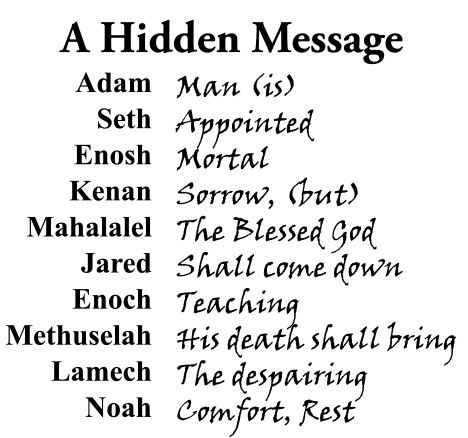
When all of that is put together, we have a summary of the Christian Gospel hidden away in the genealogy of the Torah: Man is appointed mortal sorrow but the blessed God shall come down teaching that His death shall bring the despairing comfort or rest.
Look more closely and see Who’s death is being predicted. It is God’s death.
All of this tells us that there is more going on here than just a simple list of family names. The entire thing is being designed with a profound end in view.
After Luke, we switch to Matthew.
The Birth of Jesus fulfilled the following Specifications:
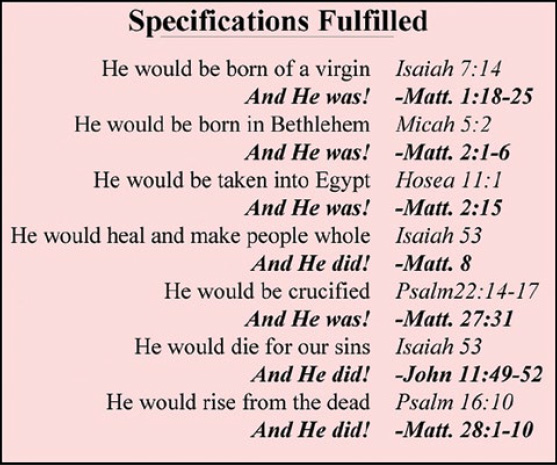
He had the most distinguished Family Tree in history:
— Encrypted in the Torah in Genesis 38
— Prophesied in Judges and Ruth 4
— Evades the blood curse on Jeconiah in Jeremiah 22:20
— Virgin Birth in Genesis 3:15; Isaiah 7:14 Psalm 69; Psalm 110
The Book of Ruth
Another amazing story about the genealogy of Jesus is in the Book of Ruth. When we carefully study Ruth and Genesis we discover that Boaz, Obed, Jesse, and David have all been prophesied in both books.
Why was Jesus born in Bethlehem? The Book of Ruth is especially important to us at Christmas because it answers that question. Bethlehem was established as the “House of David” because of the events in the Book of Ruth. That designation had implications for Joseph and Mary when Caesar Augustus ordered a special tax to be levied.
And all went to be taxed, every one into his own city. And Joseph also went up from Galilee, out of the city of Nazareth, into Judaea, unto the city of David, which is called Bethlehem; (because he was of the house and lineage of David:) To be taxed with Mary his espoused wife, being great with child.
Luke 2:3-5
Bethlehem is where the shepherds were in their fields on that momentous night:
And there were in the same country shepherds abiding in the field, keeping watch over their flock by night. And, lo, the angel of the Lord came upon them, and the glory of the Lord shone round about them: and they were sore afraid.
Luke 2:8-9
Many believe (including the author) that those fields were the fields of Boaz and Ruth, so even their fields played a part in the birth of Christ.
Ruth is the ultimate love story in many ways. It is studied in some college classes just as an elegant piece of literature quite apart from its supernatural origin. At the literary level it is much respected. But at the prophetic and personal levels it can have a profound impact on every one of us. It is one of the most significant books of the Old Testament for the church.
The Book of Ruth profiles the role of the kinsman-redeemer and is often regarded as an essential prerequisite to understanding Revelation 5. It can often be difficult to comprehend that you and I are the beneficiaries of a love story that was written in blood on a wooden cross erected in Judea some 2,000 years ago. However, knowing the story of Ruth and the ramifications of that book, brings the sacrifice of Jesus, our Kinsman-Redeemer, into sharper focus.
In Ruth, we have this interesting case where a Gentile daughter-in-law, after the death of her husband, insists upon clinging to her Jewish mother-in-law. Numerous events occur prior to a famous scene on the threshing floor where Ruth makes the request of Boaz, a rich land owner, to take her as his bride.
The major scene occurs in chapter four when Boaz confronts the relative who’s in the way of the marriage and the return of the land. This “nearer” kinsman was willing to redeem the property, but not willing to take Ruth as a bride. So he yields his shoe2 to relinquish his right of redemption. Then Boaz steps up, purchases the land for Naomi, and purchases Ruth as a bride.
As they celebrate this romantic end of this love story, there is a comment made at the wedding, “May your house be like Pharez.” At first glance, this sounds like a lovely toast at a wedding. However, the Bible has a difference perspective on it, which we will examine more closely later. The Book of Ruth provides us with a perfect outline, chapter by chapter:
The Kinsman-Redeemer
To the Greek (or Western) mind, prophecy is a prediction and a fulfillment. To the Jewish mind, prophecy is a pattern, or type. In the situation with Ruth, Boaz is acting as a kinsman-redeemer, and that role required that four conditions be met:
— He had to be a kinsman.
— He had to be able to perform the redemption.
— He had to be willing to do it.
— He had to assume all the obligations.
That is exactly what Boaz ends up doing for Ruth and Naomi, and that is exactly what Christ does for us.
— He had to be a kinsman of Adam, a human being.
— He had to be sinless in order to be able to perform the redemption.
— He had to be willing to do it. Gethsemane shows this was true.
— He also had to assume all the obligations. He has made us the people of God.
So, Boaz is the lord of the harvest and the kinsman-redeemer in the story, and he also typologically represents our Kinsman-Redeemer, Jesus Christ. Naomi is the symbol of Israel who has lost her land, but through Boaz’s act of redemption she is returned to her land. And Ruth is his Gentile bride. All of this makes the parallelism very real.
Another interesting fact about this story is that the reading of the Book of Ruth is always associated with the Feast of Shavuot, the Feast of Weeks or the Feast of Pentecost, the very feast that celebrates the birth of the church.
As we continue to examine the Book of Ruth, we notice several instructive points:
— Ruth, a Gentile, does not replace Naomi, an Israelite.
— Ruth learns of Boaz’s ways through Naomi.
— Naomi meets Boaz through Ruth.
— Boaz loved Ruth, but he had to await her move
— Boaz, not Ruth, confronts the nearer kinsman (Deuteronomy 25:5-10)3
— The Book of Ruth is always read at the Feast of Shavuot
The Strange Prophecy
There is also a very strange prophecy in the Book of Ruth:
And let thy house be like the house of Pharez, whom Tamar bare unto Judah, of the seed which the LORD shall give thee of this young woman.
Ruth 4:12
This sordid tale goes back to Genesis 38, where Tamar is forced to contrive an illegitimate son from Judah, her father-in-law, in order to continue the messianic line. She gave birth to twins, and the one connected to the Book of Ruth is Pharez (Perez), who was considered illegitimate. It would be a disdainful thing for someone at the wedding
to say, “May your house be like Pharez” because most everyone there would know about Perez as well as the Law:
A bastard shall not enter into the congregation of the LORD; even to his tenth generation shall he not enter into the congregation of the LORD.
Deuteronomy 23:2
Boaz was in the seventh generation after Perez. Ruth 4:18 has the genealogy after Perez—Hezron, Ram, Amninadab, Nashon, Salmon, Boaz, Obed, Jesse, and David. David is the tenth generation. God had planned for David to be king from the beginning. But the line had to be cleared for ten generations before David could come forth. In fact, the “tenth man” in the Old Testament is always very relevant.
The Tenth Man
| Adam | Shem | Isaac | Perez |
| Seth | Arphaxad | Jacob | Hezron |
| Enosh | Salah | Judah | Ram |
| Kenan | Eber | Perez | Amminadab |
| Mahalalel | Peleg | Hezron | Nahson |
| Jared | Rue | Ram | Salmon |
| Enoch | Serug | Amminadab | Boaz |
| Methuselah | Nahor | Nashon | Obed |
| Lamech | Terah | Salmon | Jesse |
| Noah | Abraham | Boaz | David |
This was prophesied long, long before even the days of Boaz and Ruth. In fact, look at another section of Genesis 38, the very heart of the Torah. In the Hebrew text, at 49-letter intervals, the name “Boaz” appears.
Using this pattern of a 49-letter interval for each letter, we also find the name “Ruth.”
Following her name, at a 49-letter interval, is the name “Obed,” and then “Yishay” (Jesse), and then again, continuing, there is the name of “David.”
So here we have Boaz, Ruth, Obed, Jesse, and David in 49-letter intervals, all in chronological order, hidden in the text. Statistically, the likelihood of this happening by accident or chance is absurd. This is by design.
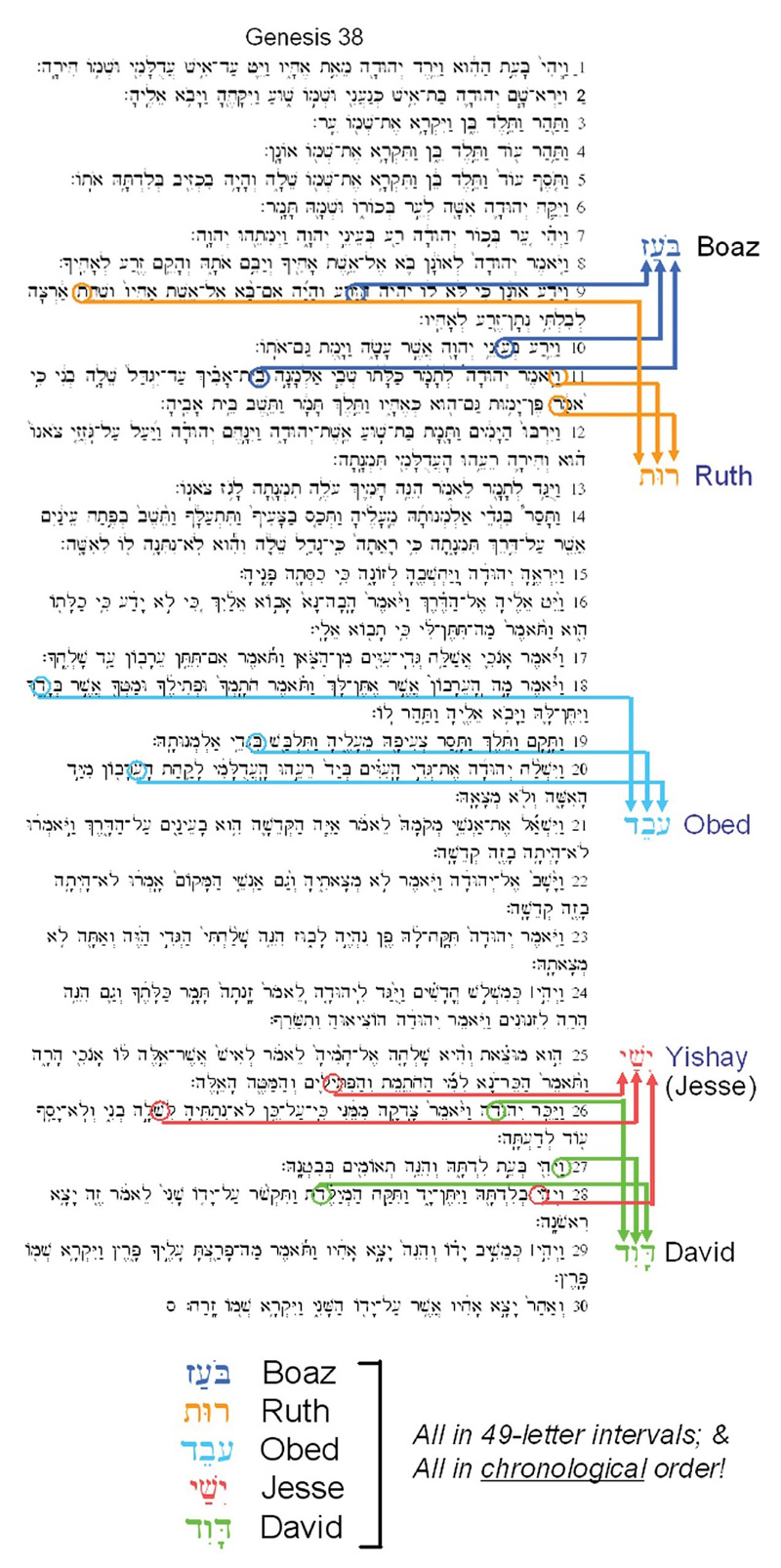
What is even more bizarre about this design is that it is in the Book, it’s in the Torah, the five books of Moses, long before Joshua, before Judges, even before Samuel the prophet, who anointed David (1 Samuel 16:13). David is a very key figure in all of these things.
Let’s take a more extensive look at the House of David. Matthew, being a Jew, began the genealogy of Jesus with Abraham. Then he goes through to David, Solomon, and on to Josiah and Jehoiakim. To really understand this, we need to back up and look at some history.
After Solomon died, the nation split into two houses: northern (Israel) and southern (Judea). The northern house went through nine different dynasties, each going from bad to worse and finally obliterated from history under the Assyrian invasion. The southern house had only one dynasty, the Davidic dynasty. Due to God’s commitment and covenant to David, there is only the one dynasty for the Jews, and it is perpetual.
Of course, some of the specific kings in that dynasty were chastised when they did not perform well, such as Ahaziah, Joash, and Amaziah--who all died violent deaths. God was thus dealing with idolatry literally “to the third and fourth generations” (Exodus 20:4, 5). Their names therefore were “blotted out” according to the Law (Deuteronomy 29:20). However, the Davidic dynasty stayed intact. When the royal line got to Jehoiachin (also called Jeconiah or Coniah), things had gotten so bad that God pronounced a blood curse on him.
The Blood Curse
Thus saith the LORD, Write ye this man childless, a man that shall not prosper in his days: for no man of his seed shall prosper, sitting upon the throne of David, and ruling any more in Judah.
Jeremiah 22:30
This is just amazing! When God pronounced this blood curse, there must have been a celebration in the councils of Satan because, from Satan’s point of view, God has put himself in a contradiction. God indicated in Genesis 49 that the Messiah was going to come from the tribe of Judah and specifically from the line of David. Then God pronounced a blood curse on that royal line that “no man of his seed shall prosper sitting upon the throne of David and ruling any more in Judah.” God’s adversaries must have been overjoyed at this. Just imagine, at this point, God turning to the angels and saying, “Watch this one.”
Pay close attention, now, because this can get complicated. The Matthew account goes down through Jehoiachin and finally gets to Joseph, who is the “legal” father of Jesus Christ. He is in the legal line of the house of David.
And Jacob begat Joseph the husband of Mary, of whom was born Jesus, who is called Christ.
Matthew 1:16
Joseph was “the husband of Mary,” not the father of Jesus Christ, except in a legal sense.
To completely understand what is going to happen here, one needs to understand an exception in the Torah that was made for the daughters of Zelophehad.
How incredible that every detail—even in the regulations of the Torah—are there by deliberate design and always point to Christ. There is a peculiar exception recorded in the Torah, the result of a petition by the daughters of Zelophehad which provided for inheritance through the daughter, if no sons were available and she married within her tribe.4 It became traditional, in such cases, that the father would legally adopt his son-in-law.5
Just to be clear, this exception provided for the husband to become the “son” of the father–of–the–bride. And this exception anticipates the lineage of Jesus Christ. It also gives credence to the concept that every detail in the Bible is not only there by design, but also impacts directly the Messiah and the Messiahship. Joseph was the son-in-law of Heli, the father of Mary. In Luke 3:23, the word that is used in the Greek is the proper usage of the verb, nomizo, which means “reckoned as by law.” The way nomizo should be translated is, “Joseph was the son-in-law of Heli” (by legal adoption).
The Virgin Birth
This miraculous event was hinted at in the Garden of Eden when God speaks of the Redeemer as “the seed of the woman…” (Genesis 3:15). That becomes a title of Jesus Christ. It was prophesied by Isaiah:
Therefore the Lord himself shall give you a sign; Behold, a virgin shall conceive, and bear a son, and shall call his name Immanuel.
Isaiah 7:14
Some skeptics quibble about the Hebrew word for “virgin” in verse 14. It is ha alma meaning “the virgin”; this is not just any virgin, but the virgin. Some say that it can mean just a young maid. If that were the case, how could that be “a sign”? Almost any young maid could conceive and bear a son. The context is clear that it means “a virgin.” In fact, in the Septuagint, three centuries before Christ was born, the Jewish translators used the Greek term parthenos, which means clearly, specifically, and scientifically “a virgin.” Those Hebrew experts, greater scholars than the modern skeptics, translated the Hebrew word ha alma, virgin, so that it is absolutely unambiguous.
The Isaiah prophecy is presented in Matthew as being fulfilled:
Now the birth of Jesus Christ was on this wise: When as his mother Mary was espoused to Joseph, before they came together, she was found with child of the Holy Ghost. Then Joseph her husband, being a just man, and not willing to make her a publick example, was minded to put her away privily.
Matthew 1:18-19
Joseph was concerned about Mary being stoned, as that was the punishment for adultery in those days.
But while he thought on these things, behold, the angel of the Lord appeared unto him in a dream, saying, Joseph, thou son of David, fear not to take unto thee Mary thy wife: for that which is conceived in her is of the Holy Ghost. And she shall bring forth a son, and thou shalt call his name JESUS: for he shall save his people from their sins. Now all this was done, that it might be fulfilled which was spoken of the Lord by the prophet, saying, Behold, a virgin shall be with child, and shall bring forth a son, and they shall call his name Emmanuel, which being interpreted is, God with us.
Matthew 1:20-23
The blood curse from Jeremiah 22 is closely tied to this issue. In fact, when we examine closely the blood curse on the royal line, the virgin birth becomes a requirement. Notice that the genealogy given in Luke comes down through Heli, who is the father-in-law of Joseph. Jesus Christ, the Messiah, is of the House and lineage of David: of the House of David legally, and of the lineage by blood. That lineage is not the bloodline through Solomon, but through Nathan, the second surviving son of David and Bathsheba. In other words, Luke takes a left turn and goes to another son—not Solomon, but Nathan.6
Note: This was an excerpt from Chuck Missler’s study The Christmas Story: What Really Happened.
Notes:
1 The Greek and Hebrew languages are distinctive in that each letter of the alphabet has a numerical value.
In Greek, a couple have been abandoned through the years, but it has that same characteristic. That means that every word has a numerical value. Also, every verb in the Greek language has to meet five independent conditions to fit in properly.
2 See Deut. 25:9-10 to understand Ruth 4:7-8. This business with the shoe was an old custom.
3 Normal procedure here, where the call to a Levirate marriage was taking place, would be for the would-be bride to confront the near kinsman. Boaz takes that responsibility and confronts the man himself
(Ruth 4:1-10).
5 Ezra 2:61; Nehemiah 7:63; Numbers 32:41, cf. 1 Chronicles 2:21-22, 34-35; Numbers 27:3-8
6 Salathiel, the (“adopted”) son of Jeconiah (Mt 1:12; 1 Ch 3:17) is also called the son of Neri (Lu 3:27). If these are the same person, a probable explanation is that the son of Neri, the descendant of Nathan, was deemed heir to the throne of David on the death of Jeconiah (Jer. 22:30) due to the blood curse. From E. W. Bullinger’s Companion Bible, App 99.


